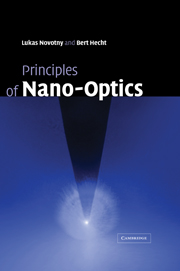Book contents
- Frontmatter
- Contents
- Preface
- 1 Introduction
- 2 Theoretical foundations
- 3 Propagation and focusing of optical fields
- 4 Spatial resolution and position accuracy
- 5 Nanoscale optical microscopy
- 6 Near-field optical probes
- 7 Probe–sample distance control
- 8 Light emission and optical interactions in nanoscale environments
- 9 Quantum emitters
- 10 Dipole emission near planar interfaces
- 11 Photonic crystals and resonators
- 12 Surface plasmons
- 13 Forces in confined fields
- 14 Fluctuation-induced interactions
- 15 Theoretical methods in nano-optics
- Appendix A Semianalytical derivation of the atomic polarizability
- Appendix B Spontaneous emission in the weak coupling regime
- Appendix C Fields of a dipole near a layered substrate
- Appendix D Far-field Green's functions
- Index
13 - Forces in confined fields
Published online by Cambridge University Press: 05 June 2012
- Frontmatter
- Contents
- Preface
- 1 Introduction
- 2 Theoretical foundations
- 3 Propagation and focusing of optical fields
- 4 Spatial resolution and position accuracy
- 5 Nanoscale optical microscopy
- 6 Near-field optical probes
- 7 Probe–sample distance control
- 8 Light emission and optical interactions in nanoscale environments
- 9 Quantum emitters
- 10 Dipole emission near planar interfaces
- 11 Photonic crystals and resonators
- 12 Surface plasmons
- 13 Forces in confined fields
- 14 Fluctuation-induced interactions
- 15 Theoretical methods in nano-optics
- Appendix A Semianalytical derivation of the atomic polarizability
- Appendix B Spontaneous emission in the weak coupling regime
- Appendix C Fields of a dipole near a layered substrate
- Appendix D Far-field Green's functions
- Index
Summary
As early as 1619 Johannes Kepler suggested that the mechanical effect of light might be responsible for the deflection of the tails of comets entering our Solar System. The classical Maxwell theory showed in 1873 that the radiation field carries with it momentum and that “light pressure” is exerted on illuminated objects. In 1905 Einstein introduced the concept of the photon and showed that energy transfer between light and matter occurs in discrete quanta. Momentum and energy conservation was found to be of great importance in microscopic events. Discrete momentum transfer between photons (X-rays) and other particles (electrons) was experimentally demonstrated by Compton in 1925 and the recoil momentum transferred from photons to atoms was observed by Frisch in 1933. Important studies on the action of photons on neutral atoms were made in the 1970s by Letokhov and other researchers in the former USSR and in the group of Ashkin at the Bell Laboratories, USA. The latter group proposed bending and focusing of atomic beams and trapping of atoms in focused laser beams. Later work by Ashkin and coworkers led to the development of “optical tweezers”. These devices allow optical trapping and manipulation of macroscopic particles and living cells with typical sizes in the range of 0.1–10 micrometers. Milliwatts of laser power produce piconewtons of force. Due to the high field gradients of evanescent waves, strong forces are to be expected in optical near-fields.
- Type
- Chapter
- Information
- Principles of Nano-Optics , pp. 419 - 445Publisher: Cambridge University PressPrint publication year: 2006
- 2
- Cited by



